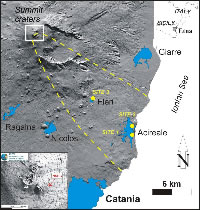PM10 measurements in urban settlements after lava fountain episodes at Mt. Etna, Italy: pilot test to assess volcanic ash hazard to human health
Andronico D. and P. Del Carlo (2016).
Natural Hazards Earth System Science, 16, 29–40, doi:10.5194/nhess-16-29-2016.
Abstract.
We have carried out a preliminary study on the potential risks caused by the sub-10 µm fraction of volcanic ash (particulate matter, PM10) after the basaltic explosive eruptions from Mt. Etna volcano (Italy), which have dramatically increased in frequency over the last 20 years. We present results deriving from the study of the ash concentration in the air following the lava fountain episode from the New Southeast Crater of Etna on 15 November 2011, which caused tephra fallout over the eastern slope of the volcano. Short-duration tests of PM10 measurements were carried out at three different sites using a TSI® DustTrakTM aerosol monitor a few hours after the end of the eruption, and readouts of the air quality were repeated at the same sites a month later without volcanic activity. Furthermore, ash samples were characterized by grain size, componentry and morphological and petrochemical analyses.
By comparing PM10 levels measured a few hours after the 15 November lava fountain and on 15 December, we found that relatively low amounts (500–1500 g m−2) of tephra fallout cause high levels of PM10 in the air. This is because the coarse particles, particularly basaltic ash, are readily broken up by traffic and hence remobilized into the air. We believe the impact from ash fallout in the Etnean territory should receive greater attention, especially regarding potential health problems. Simple but effective actions can be implemented to reduce eventual risks, first and foremost the prompt removal of the ash deposits from the urbanized areas.


